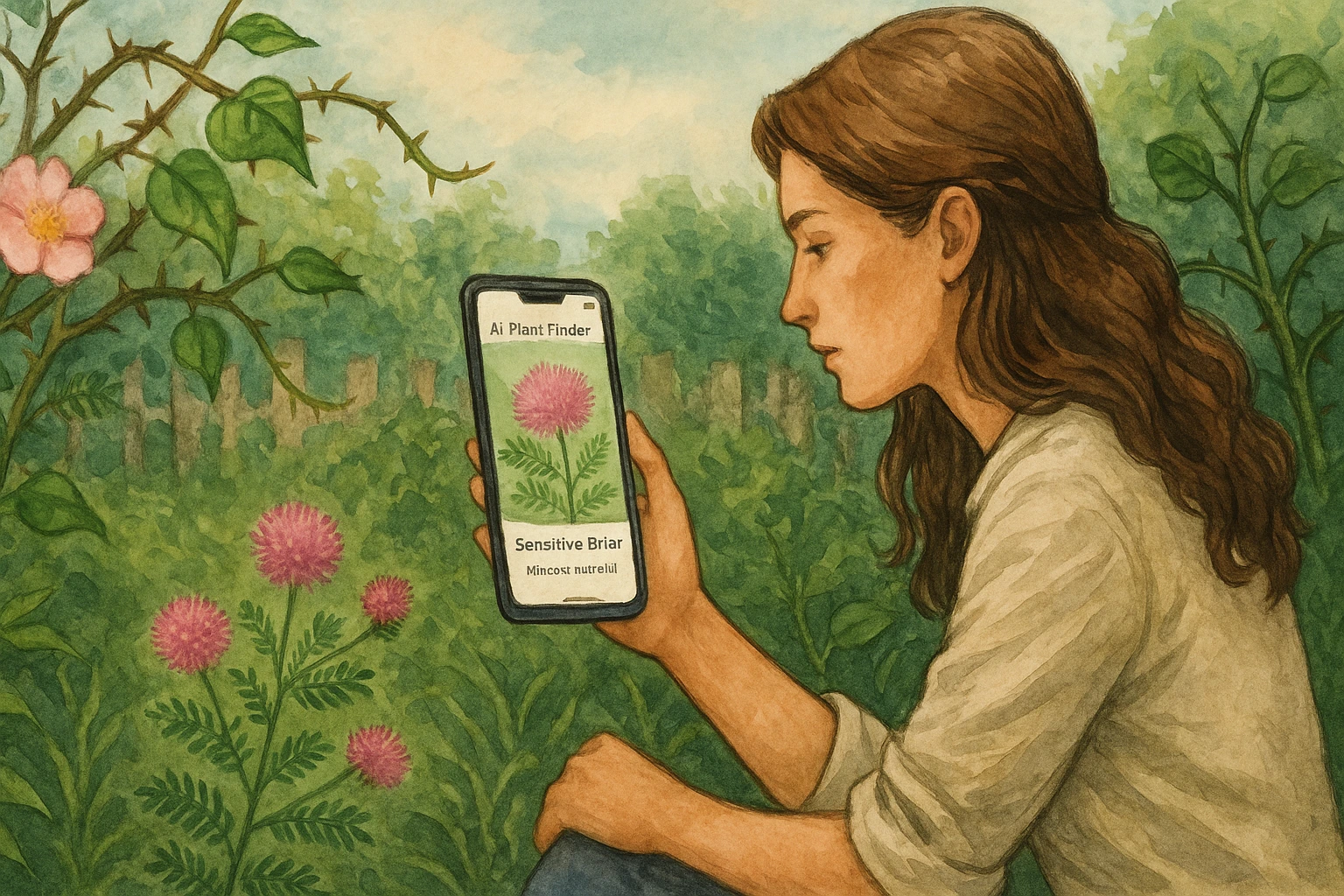.If you’ve ever wanted your garden to feel like a forgotten path in a fairy tale—part wilderness, part wonder—a briar plant is your key to unlocking that magic. Thorny yet beautiful, rugged yet enchanting, briars bridge the wild and the cultivated with ease. But beyond their dramatic silhouette and poetic allure lies a practical powerhouse for biodiversity and beauty.

What Are Briar Plants?
“Briar” is not a single plant—it’s a charmingly old-fashioned name used for a handful of tough, thorn-bearing shrubs and vines. Think of:
Sweet Briar Rose (Rosa rubiginosa): Delicate pink petals, a citrusy aroma, and hips bursting with vitamin C.
Greenbriar (Smilax spp.): Glossy, curling vines with edible shoots and a natural fencing instinct.
Catbriar: With its bluish leaves and stubborn thorns, it’s both boundary and haven for wildlife.
Sensitive Briar (Mimosa nuttallii): A low-growing, nectar-rich native with ferny leaves that react to touch.
These plants thrive in environments ranging from sun-drenched fields to woodland edges, often in soils that would discourage pickier species. Their ability to protect themselves with thorns, root deeply, and shelter other living things makes them uniquely suited to modern, sustainable garden design.
Did you know? The word "briar" comes from Old English brǣr, meaning bramble—a testament to these plants’ ancient connection with human landscapes and legends.
Why Briars Belong in a Modern Garden
Despite their old-world feel, briars are perfectly in tune with today’s garden goals: eco-conscious, low-maintenance, and rich in life. Here’s why they deserve a spot in your backyard habitat:
1. Ecological Powerhouses
Wildlife Shelter
Briar thickets provide nesting space and refuge for birds, rabbits, and other small animals. Their thorny canopies deter predators while offering security.Pollinator Support
Flowers like those of sweet briar roses attract bees and butterflies. Their long blooming season ensures consistent nourishment for pollinators.Erosion Control
Their spreading root systems stabilize loose soil and protect sloped garden beds from heavy rains or runoff.
2. Medicinal and Culinary Tradition
Edible Surprises
Sweet briar hips and greenbriar shoots can be foraged for teas, jellies, or tossed raw into salads (with care!). They offer a nutritious connection to the land.Health Heritage
Used since antiquity, rose hips are loaded with vitamin C and antioxidants. During WWII, British citizens made rose hip syrup when citrus was scarce.
3. Mystique and Ornamental Allure
Aesthetic Appeal
Briars boast graceful arching canes, fragrant blooms, and a rugged texture that adds movement and depth to garden compositions.Symbolism
In folklore, briars represent transformation, thresholds, and protection—just think of Sleeping Beauty’s enchanted hedge. In your garden, they serve as both literal and metaphorical boundary keepers.
Briar plants are not just survivors—they’re storytellers. They carry centuries of herbal use, wildlife partnerships, and mythological meaning in every thorny stem.
Growing Conditions for Briars
Briar plants are not fussy, but understanding their basic needs will help them thrive and reward you with blooms, berries, and lush foliage.

Requirement | Recommendation |
Soil | Well-draining, moderately rich soil is ideal. However, briars tolerate poor soils. |
Sunlight | Full sun to partial shade; more sunlight encourages denser blooms and foliage. |
Watering | Drought-tolerant once established, but prefer steady moisture—avoid soggy roots. |
Pruning | Annual thinning and deadheading improve shape and reduce disease risk. |
Tip: If planting as a hedge or natural barrier, space briars generously—at least 3–4 feet apart—to allow room for spread and airflow.
Pruning and Maintenance
Don’t be afraid to get hands-on with your briars—just wear gloves! These plants benefit from annual pruning in late winter or early spring. Here’s how:
Remove dead or weak stems to redirect energy into strong growth.
Thin dense thickets to improve light penetration and reduce mildew risk.
Trim post-blooming for varieties like sweet briar rose to encourage rebloom and control spread.
Certain types, like greenbriar, can be vigorous climbers. Support structures such as trellises or fences help guide their growth and add vertical interest to your garden.
Briar Plant Varieties to Consider
When choosing which briars to plant, consider your climate, wildlife goals, and garden aesthetics. Here's a breakdown of popular options:
Name | Description | Garden Benefit |
Sweet Briar Rose | Pink, apple-scented flowers; red hips rich in vitamin C | Pollinator magnet, edible, ornamental beauty |
Greenbriar (Smilax) | Waxy leaves, twining vines, edible young shoots | Culinary uses, natural fencing |
Catbriar | Rigid stems with strong thorns; bluish foliage | Wildlife barrier, deterrent plant |
Sensitive Briar | Low-growing, pink pompom blooms, leaves that move when touched | Pollinator-friendly, novelty appeal |
Wildlife Support in Action
Briar plants don’t just coexist with wildlife—they welcome it. Here’s what you might find in a well-established briar patch:
Birds nesting in sweet briar hedges
Bees and butterflies gathering nectar from delicate blooms
Hedgehogs or rabbits sheltering beneath the thorny canopy
Songbirds nibbling on late-summer rose hips
By planting briars, you’re creating an ecosystem—not just an aesthetic. They form a living bridge between structured garden design and the spontaneous rhythms of nature.
Growing Conditions for Briars
Briar plants are not fussy, but understanding their basic needs will help them thrive and reward you with blooms, berries, and lush foliage.
Requirement | Recommendation |
Soil | Well-draining, moderately rich soil is ideal. However, briars tolerate poor soils. |
Sunlight | Full sun to partial shade; more sunlight encourages denser blooms and foliage. |
Watering | Drought-tolerant once established, but prefer steady moisture—avoid soggy roots. |
Pruning | Annual thinning and deadheading improve shape and reduce disease risk. |
Tip: If planting as a hedge or natural barrier, space briars generously—at least 3–4 feet apart—to allow room for spread and airflow.
Briar Plant Varieties to Consider
When choosing which briars to plant, consider your climate, wildlife goals, and garden aesthetics. Here's a breakdown of popular options:
Name | Description | Garden Benefit |
Sweet Briar Rose | Pink, apple-scented flowers; red hips rich in vitamin C | Pollinator magnet, edible, ornamental beauty |
Greenbriar (Smilax) | Waxy leaves, twining vines, edible young shoots | Culinary uses, natural fencing |
Catbriar | Rigid stems with strong thorns; bluish foliage | Wildlife barrier, deterrent plant |
Sensitive Briar | Low-growing, pink pompom blooms, leaves that move when touched | Pollinator-friendly, novelty appeal |
Wildlife Support in Action
Briar plants don’t just coexist with wildlife—they welcome it. Here’s what you might find in a well-established briar patch:
Birds nesting in sweet briar hedges
Bees and butterflies gathering nectar from delicate blooms
Hedgehogs or rabbits sheltering beneath the thorny canopy
Songbirds nibbling on late-summer rose hips
By planting briars, you’re creating an ecosystem—not just an aesthetic. They form a living bridge between structured garden design and the spontaneous rhythms of nature.

